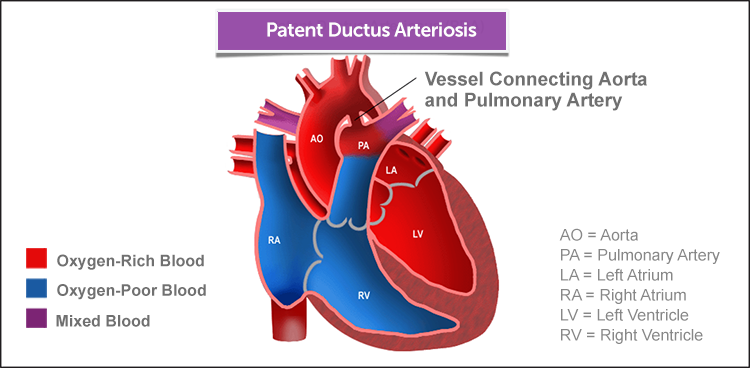Patent Ductus Arteriosus | Diagnosis & Treatments
How is patent ductus arteriosus diagnosed?
Patent ductus arteriosis is often first detected when your doctor hears an abnormal heart sound or heart murmur when listening to your baby’s heart.
Depending on the type of murmur your doctor hears, he or she may order further testing such as:
- chest x-ray
- electrocardiogram (ECG or EKG)
- echocardiogram (cardiac ultrasound)
- cardiac catheterization
- cardiac magnetic resonance imaging (MRI)
What are the treatment options for patent ductus arteriosus?
A small patent ductus arteriosus may close on its own as your child grows. For infants with a large patent ductus arteriosus who do not have any symptoms, the repair may be delayed until the child is bigger. If your child has a patent ductus arteriosus that causes symptoms (like difficulty breathing or difficulty gaining weight appropriately) or that strains the heart, a cardiologist will check periodically to see whether the patent ductus is closing on its own. If it remains open, it can be actively closed with a medicine or procedure.
Medication
The goal is to close the patent ductus arteriosus before the lungs become damaged from too much blood flow. In premature infants, medications may help close the patent ductus. These medications include indomethacin, ibuprofen, Tylenol, each working by stimulating the muscles inside the patent ductus arteriosus to tighten, closing the connection. Your child's physician can answer any questions you may have about this treatment.
Catheter-based closure
In many cases your child's patent ductus arteriosus may be repaired by a cardiac catheterization procedure. During cardiac catheterization, your child is sedated and a small, thin, flexible tube (catheter) is inserted into a blood vessel in the groin and guided through the inside of the heart into the patent ductus arteriosus. Once the catheter is in the patent ductus arteriosus, the cardiologist will use this catheter to place a special device, called an occluder, which is designed to completely seal the ductus, preventing blood from flowing through it.
Recently, a new transcatheter device was approved by the FDA to close a patent ductus arteriosus in extremely low birth weight newborns, making it possible for many more patients to benefit from this minimally invasive procedure.
Surgical repair
Surgical repair (ligation) is recommended for children for whom a catheter-based procedure is not an option. Your child's cardiologist will recommend when a transcatheter device or surgical repair should be performed.
The ligation procedure is performed under general anesthesia. The procedure involves making an incision in the skin and chest wall to reach the patent ductus arteriosus, and then closing the ductus from the outside with a clip or suture.
What is the long-term outlook for patent ductus arteriosus?
Most children with a patent ductus will live healthy lives after recovering from the repair. Their activity levels, appetite, and growth should return to normal.


